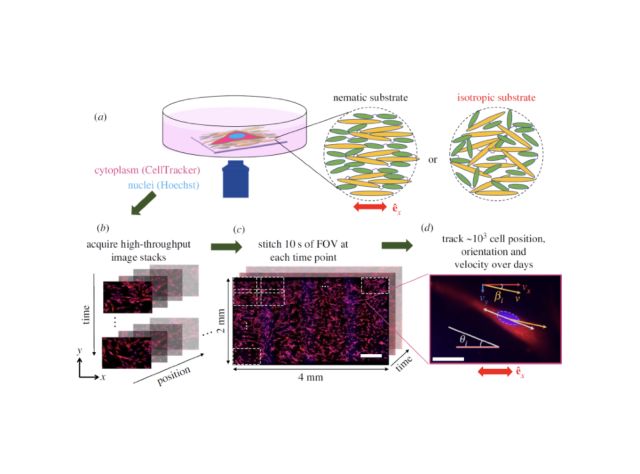Molecular-scale substrate anisotropy, crowding and division drive collective behaviours in cell monolayers

PIs and Institution
Yimin Luo, Mengyang Gu, Juan Manuel Urueña, Javier Read de Alaniz, Matthew E. Helgeson, and Megan T. Valentine, UC Santa Barbara
Achievement
Cells have the ability to reorganize in response to external cues, which is crucial for engineering new tissues. While nematic order (alignment of elongated particles in a specific direction) is typical in biological tissues, it's usually confined to small regions of cells with steric repulsion interactions. In this study, the researchers found that flat substrates with nematic order can induce large-scale alignment of dense, spindle-like cells, impacting their collective organization and motion on a tissue-wide scale. The study's comprehensive quantitative analysis and orientational correlations for thousands of cells over days revealed that enhanced cell division along the substrate's nematic axis and associated extensile stresses play a role in establishing global order. Surprisingly, individual cells were not affected by the substrate's anisotropy; instead, the emergence of global nematic order appeared to be a collective phenomenon that depended on both steric effects and the molecular-scale anisotropy of the substrate. The insights gained from this study have implications for various applications, ranging from fundamental biology to tissue engineering.
Importance of the Achievement
The study sheds light on the mechanisms that drive the organization of cells in response to external stimuli. The discovery that nematic substrates can induce global nematic alignment of densely packed cells challenges existing knowledge and underscores the crucial role of molecular-level substrate anisotropy in driving collective cell behavior. The study enhances our understanding of how cellular remodeling occurs in systems of weakly interacting cells, potentially influencing the design of materials and environments that impact cell behavior. This knowledge could contribute to the design of improved biomaterials that encourage desirable cell behaviors as well as tissue engineering.
Unique Features of BioPACIFIC MIP that Enabled this Achievement
The use of the BioPACIFIC MIP microrheology facility was crucial in effectively tracking the intricate trajectories of molecules. The implementation of the in-house software not only streamlined data analysis but also led to a noteworthy reduction in computational time.